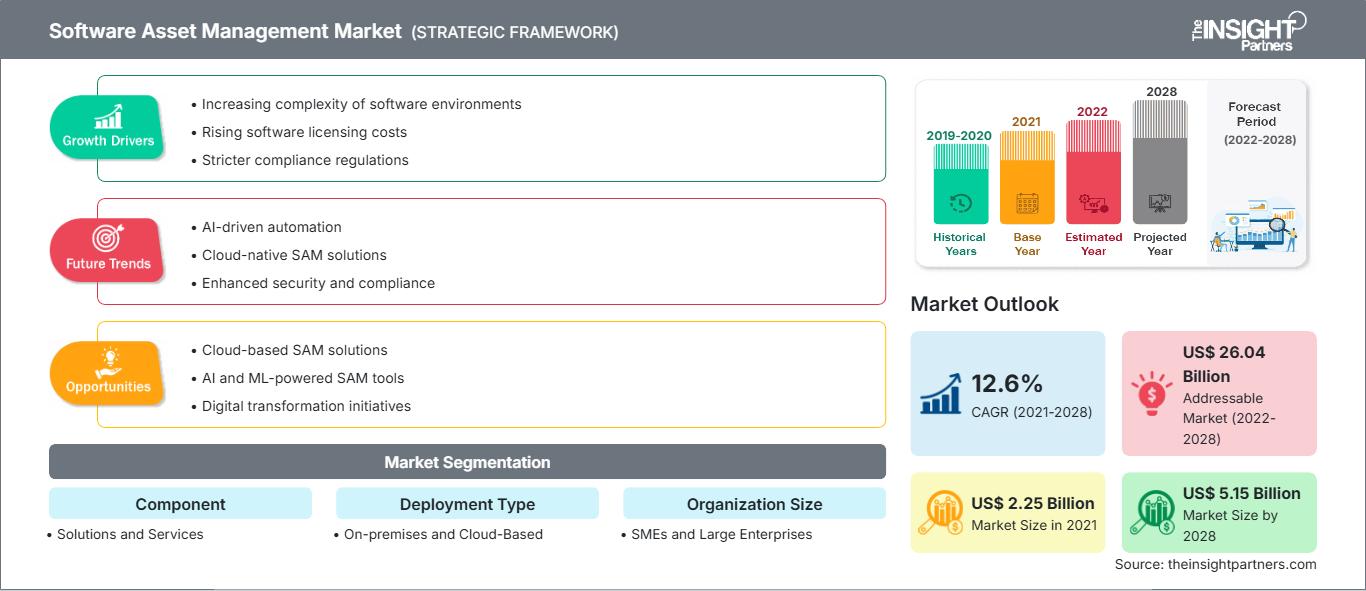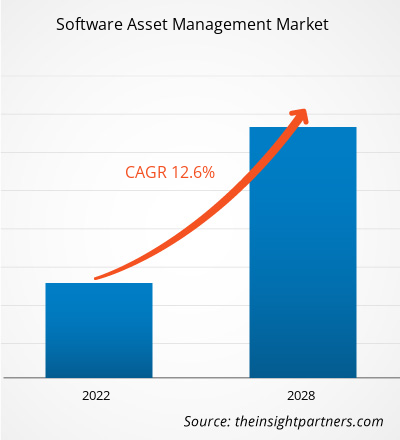[研究报告]软件资产管理市场预计将从 2021 年的 22.5037 亿美元增长到 2028 年的 51.5051 亿美元;预计 2021 年至 2028 年的复合年增长率将达到 12.6%。
软件资产管理 (SAM) 是指对组织内部软件应用程序的采购、实施、使用、维护和处置所需的系统、规则和程序进行管理。软件资产管理市场是 IT 资产管理的一个组成部分,旨在确保公司遵守许可协议,避免在软件上支出过高。软件资产的识别、最终用户许可协议 (EULA) 的有效性以及免费软件的合理使用都是任何 SAM 工作的关键目标。 SAM 文档可以保护公司免受反盗版诉讼,最大限度地减少意外的许可证滥用,并控制网络上的影子软件。
大型组织中的软件资产管理可能非常复杂,需要开发和维护一个数据库来维护软件购买、订阅、许可证和补丁的信息。这样的团队通常负责续订软件许可证、协商新的许可协议,以及检测和删除很少或从未使用过的软件。软件资产管理市场会审核已购买的软件许可证数量,并将其与已安装的许可证数量进行核对,以自动化从众多移动、桌面、数据中心和云库存来源获取信息。SAM 工具还可以跟踪剩余的许可证数量。为了降低成本,可以利用这些信息来删除或重新分配未使用的软件。
自定义此报告以满足您的要求
您将免费获得任何报告的定制,包括本报告的部分内容,或国家级分析、Excel 数据包,以及为初创企业和大学提供超值优惠和折扣
软件资产管理市场: 战略洞察

-
获取本报告的主要市场趋势。这个免费样本将包括数据分析,从市场趋势到估计和预测。
新冠疫情对软件资产管理市场的影响
新冠疫情使软件资产管理市场受益。由于新冠疫情,企业面临着新的挑战,例如远程办公环境的兴起。新冠疫情的爆发凸显了采用数字技术并充分利用软件资产管理解决方案和服务的潜力以优化许可证和成本并提高IT资产投资回报率的必要性。此外,2020年新冠疫情的到来也给全球市场运营带来了一系列挑战。由于发达经济体的医疗基础设施因病例增加而崩溃,公共卫生紧急状况将需要政府和市场参与者进行干预,并通过合作开展研发计划来协助恢复市场运营和收入,以弥补预测期(截至 2028 年)内的损失。此外,增加的投资预示着未来几年该行业将表现良好。
市场洞察 - 软件资产管理市场
资产生命周期管理需求的不断增长推动了对软件资产管理市场的需求
所有流程和 IT 基础设施用户都需要在公司的软件资产的整个生命周期内对其进行管理、监管和保护。IT 资产管理 (ITAM)、IT 服务管理 (ITSM) 和硬件资产管理 (HAM) 都是软件资产管理 (SAM) 的子集。ITAM 旨在改进软件和硬件资产管理,同时优化成本节约并限制审计风险。现代企业将软件视为其日常运营不可或缺的要素。平均而言,一家企业会使用 288 个应用程序来协助员工完成各种任务。通过成功实施资产生命周期管理或生命周期资产管理 (LCAM),战略企业可以确定资产何时达到峰值性能以及还能为企业服务多长时间。例如,Blissfully 是一款软件资产管理和软件即服务 (SaaS) 管理应用程序,可以帮助企业节省资金、管理所有软件提供商、提高生产力并增强软件系统的安全性。因此,日益增长的资产生命周期管理需求推动了软件资产管理市场的需求。
组件细分洞察 - 软件资产管理市场
基于组件,软件资产管理市场细分为解决方案和服务。软件资产管理解决方案可帮助数据中心运营经理识别、定位、可视化和管理所有资产,并规划未来增长的容量。实施软件资产管理计划具有战术目的 - 将获得的软件许可证数量与实际消耗或使用的许可证数量相匹配。成功的软件资产管理方案必须确保所有已安装软件的使用均符合各个供应商许可协议的条款和条件,并确保购买的许可证数量与实际使用量相平衡。如果接受软件供应商或第三方(例如商业软件联盟 (BSA))的审核,公司可以减少与软件盗版相关的责任。
部署类型细分洞察 - 软件资产管理市场
根据部署类型,软件资产管理分为本地部署和云端部署。云端软件资产管理解决方案更易于在不同屏幕尺寸的设备(台式机、笔记本电脑、平板电脑、手持设备和智能手机)上使用。RFID、条形码和 NFC 数据也可以保存在云端,从而更易于检索。云端系统易于访问,非常适合多地点以及内外部资产审计相结合的情况。从多台设备上传资产照片和添加备注通常更为简便。基于云的软件资产管理解决方案可以轻松实现版本控制、审计和多审批链。
组织类型细分洞察
根据组织类型,软件资产管理市场可分为中小型企业和大型企业。大型企业可能会在高端软件上投入巨资,以提高公司生产力。更大型的企业则需要 SAM 工具。使用软件资产管理工具可以自动化、加速和改进手动流程。此外,软件资产管理可帮助各个垂直行业的组织有效提高其 IT 资产的性能和灵活性。
行业垂直细分洞察 - 软件资产管理市场
根据行业垂直领域,软件资产管理市场细分为政府、零售和消费品、医疗保健和生命科学、BFSI、媒体和娱乐、制造、IT 和电信等。数字技术正在改变制造业开展业务的方式。据估计,技术将在工业4.0中发挥巨大作用。软件资产管理将成为这一新制造时代的关键要素。
参与者专注于新产品的创新和开发,通过整合先进技术和功能来提升竞争力。据全球领先的技术情报公司Snow Software称,Snow Atlas是唯一一个从零开始开发的集成平台,旨在帮助企业识别、监控和优化其本地和云端技术投资。软件和资产管理 (SAM)、软件即服务 (SaaS) 管理和IT服务管理 (ITSM) 集成以服务形式交付,是首批可在新的云原生平台上访问的解决方案,这些解决方案存在于软件访问管理解决方案中。
根据组件,软件资产管理市场细分为解决方案和服务。根据部署类型,软件资产管理分为本地部署和云端部署。根据组织类型,软件资产管理市场可分为中小型企业和大型企业。根据行业垂直划分,软件资产管理市场可细分为政府、零售和消费品、医疗保健和生命科学、金融服务和保险业、媒体和娱乐、制造业、IT 和电信等。根据地区划分,全球软件资产管理市场可细分为北美、欧洲、亚太地区、中东和非洲以及南美。
软件资产管理市场
软件资产管理市场
The Insight Partners 的分析师已详尽阐述了预测期内影响软件资产管理市场的区域趋势和因素。本节还讨论了北美、欧洲、亚太地区、中东和非洲以及南美和中美洲的软件资产管理市场细分和地域分布。
软件资产管理市场报告范围
| 报告属性 | 细节 |
|---|---|
| 市场规模 2021 | US$ 2.25 Billion |
| 市场规模 2028 | US$ 5.15 Billion |
| 全球复合年增长率 (2021 - 2028) | 12.6% |
| 历史数据 | 2019-2020 |
| 预测期 | 2022-2028 |
| 涵盖的领域 |
By 组件
|
| 覆盖地区和国家 |
北美
|
| 市场领导者和主要公司简介 |
|
软件资产管理市场参与者密度:了解其对业务动态的影响
软件资产管理市场正在快速增长,这得益于终端用户需求的不断增长,而这些需求又源于消费者偏好的不断变化、技术进步以及对产品优势的认知度不断提升等因素。随着需求的增长,企业正在扩展其产品线,不断创新以满足消费者需求,并抓住新兴趋势,从而进一步推动市场增长。

- 获取 软件资产管理市场 主要参与者概述
软件资产管理市场 -公司简介
- 微软公司
- IVANTI
- SNOW SOFTWARE
- BMC SOFTWARE, INC.
- CERTERO
- FLEXERA
- IBM Corporation
- MICRO FOCUS
- SERVICENOW
- BROADCOM,公司
- 历史分析(2 年)、基准年、预测(7 年)及复合年增长率
- PEST和SWOT分析
- 市场规模、价值/数量 - 全球、区域、国家
- 行业和竞争格局
- Excel 数据集
近期报告
相关报告
客户评价
购买理由
- 明智的决策
- 了解市场动态
- 竞争分析
- 客户洞察
- 市场预测
- 风险规避
- 战略规划
- 投资论证
- 识别新兴市场
- 优化营销策略
- 提升运营效率
- 顺应监管趋势






















 获取免费样品 - 软件资产管理市场
获取免费样品 - 软件资产管理市场